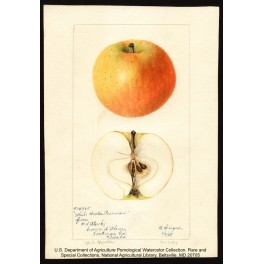More info
White Winter Pearmain
Synonyms: Cambellite, Campbellite, Camplellite, Pearmain Blanche d'Hiver, Pearmain d'Hiver Blanche, White Pearmain, Winter White Pearmain
Mother to: Indo
Source: www.nationalfruitcollection.org.uk
The National Archives Open Government Licence
An excerpt from Beach’s Apples of New York, Volume I:
WHITE PEARMAIN.
REFERENCES, 1. N. Y. Agr. Soc. Trans., 1849:124. 2. Phoenix, Horticulturist, 4:471. 1850. 3. Downing, 1857:110. fig. 4. Hooper, 1857:59, 60, 99, 100. 5. Am. Pom. Soc. Cat., 1858. 6. Mag. Hort., 27:60, 62. 1861. 7. Warder, 1867:508. 8. Thomas, 1875:232. 9. Barry, 1883:357. 10. Wickson, 1889:248. ii. Bailey, An. Hort., 1892:252. 12. Stinson, Ark. Sta. An. Rpt., 7:47. 1894. 13. Am. Pom. Soc. Cat., 1897:15. 14. Dickens and Greene, Kan. Sta. Bul, 106:56. 1902. 15. Powell and Fulton, U. S. B. P. I. Bul, 48:60. 1903. 16. Budd-Hansen, 1903:201. fig.
SYNONYM. WHITE WINTER PEARMAIN (1, 2, 3, 4, 5, 6, 7, 8, 9, 10, n, 12, 14). White Winter Pearmain (15, 16).
This is an old favorite dessert apple in portions of the Middle West from Ohio to Kansas. It appears to succeed better in those regions than it does in New York. It is not recommended for planting in this state.
Historical. Warder says “This favorite fruit was brought to Indiana by some of the early pomologists, in the days of saddle-bag transportation. In a lot of grafts, two varieties, having lost their labels, were propagated and fruited without name. Being considered Pearmain-shaped, they were called respectively Red and White Winter Pearmains. The former proved to be the Esopus Spitzenberg; the latter has never yet been identified, though believed to be an old eastern variety." For a time it was confused with an old New Jersey apple by the name of Michael Henry Pippin, and Elliott fell into the error of publishing White Pearmain and White Winter Pearmain as synonyms of Michael Henry Pippin1but it was finally conceded that White Pearmain and Michael Henry Pippin are distinct varieties (4, 7). In 1858 it was catalogued by the American Pomological Society as White Winter Pearmain (5). Since 1897 (13) it has been listed as White Pearmain but it is very doubtful whether this change will be generally accepted by fruit growers and fruit dealers. This variety has been little grown in New York and is now seldom or never planted here.
Tree vigorous. Form spreading. Twigs short, stout, blunt at tips, generally straight; internodes vary from short to long. Bark reddish-brown overlaid with heavy scarf-skin, quite pubescent. Lenticels conspicuous, numerous, above medium, elongated, raised. Buds large, projecting, acute, quite pubescent, free.
Fruit below medium to nearly large, uniform in size and shape. Form roundish ovate or roundish approaching oblong conic, varying to roundish conic, somewhat ribbed, pretty symmetrical. Stem medium to long. Cavity rather small to above medium, acute, deep, moderately narrow to broad, somewhat furrowed, sometimes russeted. Calyx medium to large, usually closed; lobes long, acute. Basin small to medium, oblique, shallow and obtuse to medium in depth and rather abrupt, medium in width, often distinctly fur- rowed, wrinkled, pubescent.
Skin tough, smooth, slightly waxen, pale yellow, or at first greenish, with a shade of brownish-red. Dots numerous, pale or russet, often submerged, usually larger and much elongated about the cavity.
Calyx tube long, conical.
Core medium to rather large; cells closed or partly open; core lines somewhat clasping. Carpels rather flat, broad or roundish-cordate, emarginate, mucronate, tufted. Seeds light brown, medium to large, rather wide, plump, obtuse to acute, tufted.
Flesh slightly tinged with yellow, firm, fine-grained, crisp, tender, juicy, mild subacid, sprightly, very pleasantly aromatic, very good to best.
Season December to March.
1 Elliott, 1854:91.
Beach, S.A. The Apples of New York, Volume I. J.B. Lyon Company, 1905


